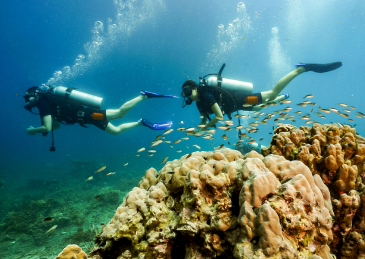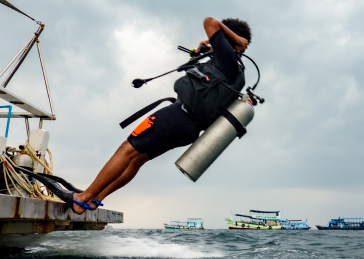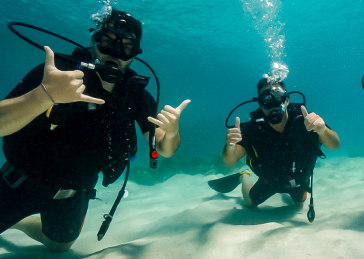18th June 2024
PADI (Professional Association of Diving Instructors) is a worldwide known organization that provides a step-by-step certification process.
RAID (Rebreather Association of International Divers) is an organization that emphasizes practical skills and eco-friendly diving practices.
Both PADI and RAID offer a variety of certifications, from beginner to professional levels.
The training methods are different, with PADI focusing on knowledge development and RAID emphasizing in-water practice.
Whether you choose PADI or RAID will depend on your learning preferences, environmental values, and diving goals.
Understanding PADI and RAID: Diving Certifications Explained

“Scuba Diving Certification: Should You …” from www.frommers.com and used with no modifications.
When it comes to diving certifications, two names often come to mind: PADI and RAID. These organizations are the leaders in the world of scuba diving, guiding diving enthusiasts into the depths of the ocean with their unique training programs. But as someone who is eager to explore the underwater world, you might be wondering, “What’s the difference between PADI and RAID, and which one should I choose?” Let’s dive in and compare these two top dive certification agencies.
Getting to Know PADI’s Open Water Certification
For those who are new to diving, PADI’s Open Water Diver course is your ticket to the underwater realm. It’s the most widely taken beginner course around the world, and here’s the reason:
This course will teach you the fundamentals of diving, such as how to use equipment, navigate underwater, and follow safety protocols.
The course is a blend of theory (which can be done online or in a classroom), confined water dives for skill practice, and four open water dives.
Once certified, you can dive up to 18 meters (60 feet) with a buddy.
The key point is that PADI’s structured approach is designed to gradually build your confidence and competence. It’s a proven method that has introduced millions to diving.
Looking into the RAID Core Diver Course
The RAID Open Water 20, RAID’s beginner course, is becoming popular due to its modern method of teaching divers. Here’s what you need to know:
There is a strong emphasis on buoyancy control in the course, which is vital for a safe and enjoyable dive.
RAID takes pride in its green ethos, teaching divers to be aware of their impact on marine environments.
Unlike PADI, once you’ve finished the course, you’ll be certified worldwide to dive up to 20 meters (66 feet), instead of 18 meters (60 feet)
RAID’s emphasis on practical skills from the start means you’ll spend more time in the water, honing your skills with a strong sense of environmental responsibility.
Entry-Level Requirements and Outcomes: A Comparison
Whether you choose PADI or RAID, you need to be healthy, at ease in the water, and at least 10 years old to get a junior certification. The end result is the same for both: you become a certified diver ready to dive into the ocean. However, the path to get there differs. PADI may offer a more conventional approach, while RAID provides a contemporary, practical experience.
How Much Will I Pay for PADI Certification?
When you’re deciding which dive certification to get, cost is a big factor. The Open Water Diver course from PADI, which is what you need to become a certified diver, usually costs anywhere from $350 to $500. This fee usually includes your learning materials, gear rental, instructor fees, and the cost of certification. Keep in mind that prices can vary depending on where you are and which dive center you go to, so it’s a good idea to shop around and see what fits your budget.
Cost of RAID Certification: A Quick Look
The RAID Open Water 20 course is priced competitively, often in line with PADI, and usually runs between $300 to $500. This typically includes your digital learning materials, rental of dive equipment during the course, instructor fees, and the certification itself. RAID boasts a digital-only learning approach, which can sometimes make its materials more accessible and, in some cases, cheaper.
Extra Expenses: Diving Gear and Travel Factors
In addition to the cost of the course, there are other expenses to think about. No matter which organization you choose, you’ll eventually need to buy your own basic equipment, like a mask, snorkel, and fins. This could cost you an extra $100 to $300. If you’re taking a diving course while on holiday, remember to include travel costs, lodging, and any additional dives you may want to do outside of the course. These expenses can add up, but they’re all part of the amazing journey of becoming a diver.
Comparing Dive Experiences: PADI and RAID’s Diver Training Methods

Scuba diving is more than just an adrenaline rush; it’s a skillset. Both PADI and RAID provide well-rounded dive experiences, but their methods for doing so are somewhat different.
What to Expect from PADI’s Controlled Open Water Dives
With PADI, your first breaths underwater will be in a controlled, safe environment. The training starts in a pool or confined water, where you can learn and practice skills in calm, clear conditions. From there, you move on to open water dives, where you apply what you’ve learned in the ocean or a lake. This systematic, step-by-step approach is designed to build your confidence as you gradually experience more challenging diving conditions.
RAID’s Practical Training Approach
RAID’s training approach is all about getting you comfortable in the water as soon as possible. You’ll start in confined water, but the focus is on simulating real-world conditions from the start. RAID believes that by practicing buoyancy control and other essential skills in scenarios that mimic actual dives, you’ll be better prepared for the unpredictable nature of the ocean.
Safety Protocols and Risk Assessment in Training
Safety is the most important thing when it comes to diving. Both PADI and RAID stress the importance of risk assessment and safety protocols throughout their training. You’ll learn how to check your gear, plan your dives, and manage potential underwater hazards. The goal is to make you not just a diver, but a responsible member of the diving community, equipped to handle the challenges of the underwater world with respect and caution. For more in-depth information on safety protocols, you might want to consider reading about essential dive safety protocols.
Worldwide Recognition: PADI and RAID’s Acceptance in the Diving Industry

“Indian Vastu Shastra | World global …” from vastuplus.com and used with no modifications.
As a certified diver, the world’s oceans are your oyster, but you’ll need to ensure your certification is accepted wherever you choose to dive. This is the importance of worldwide recognition.
PADI’s Global Network and Connections
With over 6,600 dive centers and resorts, PADI is the largest scuba diving training organization in the world. Where there’s water, there’s likely a PADI center. This broad reach means you can dive with peace of mind, knowing your certification will be acknowledged almost anywhere you travel.
RAID’s Rising Popularity Among Divers
RAID may be newer to the scene than PADI, but it’s rapidly gaining traction as the fastest growing agency worldwide. More and more dive centers are recognizing RAID certifications, and its global presence is expanding. RAID’s dedication to maintaining high standards and promoting environmental awareness is also helping it to earn respect in the diving community.
Global Acceptance and Portability of Certifications
Whether you opt for PADI or RAID, your certification will give you access to dive sites worldwide. PADI currently enjoys wider recognition due to its longevity, but RAID’s certifications are also one hundred percent accepted at all worldwide locations. The most crucial factor is to ensure that the dive center you select maintains safety standards and has a good reputation.
PADI and RAID: Final Thoughts on Choosing Your Diving Certification
Deciding between PADI and RAID isn’t just about choosing a certificate; it’s about picking an experience that speaks to you.
What are your personal goals and how do they align with the teaching philosophies?
Think about what your personal goals are and how you learn. If you like to learn in a structured, step-by-step way, then PADI might be the better option for you. If you prefer a more flexible, environmentally focused way of learning, then you might be better off with RAID. Your journey to certification should be in line with your preferred learning style and what you want to get out of diving.
How Certification Affects Diving Opportunities
Whether you choose PADI or RAID, earning a certification opens up a world of diving opportunities. It’s like getting a passport to explore coral reefs, shipwrecks, and all the sea life under the waves. The certification is important, but it’s really about the skills you learn and the experiences you have that make the journey worthwhile.
Looking back at the pros and cons of both PADI and RAID, it’s obvious that each has its own special advantages. PADI’s large network and universally accepted certifications make it a dependable choice for divers who want a structured, widely recognized training program. Conversely, RAID’s dedication to eco-friendly practices and a more adaptable learning structure appeals to those who value environmental conservation and contemporary education methods.
Ultimately, the choice between PADI and RAID comes down to what you value in a scuba certification program. If you prefer a more traditional, classroom-based learning experience and want to be part of a large global community, PADI may be the choice for you. On the other hand, if you’re drawn to a more modern, digital-first approach to learning, you might find RAID more appealing. Regardless of which organization you choose, you’ll be joining a community of enthusiastic divers ready to explore the depths of the ocean.
Common Questions
As we conclude our look into the differences between PADI and RAID, we’ll answer some questions that you might have as a future diver.
Is it possible to switch from PADI to RAID or the other way around?
Indeed, divers are able to switch between PADI and RAID certifications. For example, if you did your Open water with PADI you’d be able to do your advanced open water course with RAID (Explorer 30
Both agencies have systems in place for divers who wish to cross over or continue their education with the other organization.
It is advised to consult with local dive centers for specific crossover course prerequisites.
Regardless of whether you’re transitioning from PADI to RAID or vice versa, the process is generally simple. Above all, both organizations place a high value on diver safety and skill development, so your prior experience will be appreciated and acknowledged.
How do PADI and RAID certifications affect my ability to dive internationally?
Both PADI and RAID certifications are recognized internationally, enabling divers to explore waters all around the world. PADI’s extensive network makes it simple to locate dive centers and resorts that recognize its certifications. RAID, although newer, is also establishing a strong global presence. When planning international dives, it’s always a good idea to verify that the local dive centers acknowledge your certification agency.
When it comes to advanced certifications, the time and cost will depend on the level of certification and the dive center. The Advanced Open Water Diver course from PADI usually takes between 2 and 3 days and costs between $300 and $400. The Advanced 35 course from RAID can also take a similar amount of time and cost. The price can change depending on the location and what is included.
How frequently should I take a refresher course with PADI or RAID?
Both PADI and RAID suggest that divers who have not been diving for a while—typically six months or longer—should take a refresher course. PADI’s ReActivate programme and RAID’s equivalent are meant to help you brush up and practice your diving skills so you can dive with confidence and safety. The price and length of these refreshers can vary, but they’re essential for making sure you’re ready to dive.
Dive with LBD: Your Gateway to Underwater Exploration
Whether you’re a curious beginner or a seasoned pro, our school is your portal to the wonders of scuba diving. Join us into the world beneath the waves.
READY TO GET STARTED?
Check our diving courses in Koh Tao



